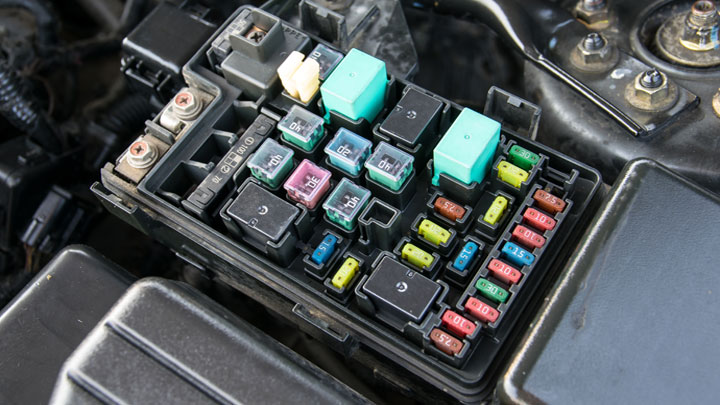Last Updated on January 5, 2022
Your turn signal is one of the most important safety features in your vehicle, even if it is one of the most overlooked. But what do you do when the feature you take for granted stops working?
Well, you start digging into how the blinkers work of course! And once you start digging, one of the first components you’ll come across is the turn signal relay.
But how do you know if the turn signal relay is working properly, and how much can you expect to spend if you need to replace it? We’ll answer those questions and more for you here.
What is a Turn Signal Relay?
Your turn signal relay, also known as the flasher relay, is the component that is responsible for your turn signals turning on and off every time you put on a turn signal or hit the hazards.
It’s an electrical component that acts as a relay, and it switches on and off continuously whenever the button is depressed.
The turn signal relay is the component you hear when you listen to the clicking sound you hear every time one of these components is on.
Where is it Located?

It really depends on which type of vehicle you drive, but on most models, you can find your turn signal relay inside the junction box or the fuse box with your other relays.
Some vehicles have a guide that will tell you which relay does what right on the fuse box cover, others make you dive into the owner’s manual to find that information.
Other vehicles (ie: Toyota/Lexus) make it more difficult to get to the relay and may require you to remove a kick panel near your steering wheel. You can verify its location by using a factory service manual.
Read Also: HID vs LED Headlights
Bad Turn Signal Relay Symptoms
Just because you know where something is and what it does, doesn’t mean you’re ready to jump in and replace it. Below we’ve highlighted three common signs that you might need to replace your turn signal relay.
While we’ve highlighted three common symptoms of a bad turn signal relay here, we want to highlight that if your turn signal is blinking too fast, there’s likely causing another issue causing the problem besides the turn signal relay.
#1 – Turn Signal or Hazards Stop Working

By far the most common symptom of a faulty turn signal relay is that your turn signals or hazards stop working properly. Since it’s the job of the turn signal relay to tell the turn signals to turn on, it makes perfect sense that if this component breaks, you’ll lose that feature.
If the relay breaks in a way that it won’t open anymore or if a piece breaks off creating an open circuit, then neither your turn signal nor hazards will work.
#2 – Turn Signal or Hazards Won’t Turn Off

While the turn signal or hazards stopping working is the most likely sign of a faulty turn signal relay, it’s not the only one. Another possible symptom is that you can’t get the turn signals or hazards to turn off. This happens when the turn signal relay breaks while in the on position.
While it’s less likely to happen this way since it requires a piece of the relay to get stuck “closed” instead of breaking off as more common, it still can happen.
#3 – Other Lights Malfunction

While it’s by far the least common symptom of a broken turn signal relay, as any mechanic can tell you, electrical problems can create weird results. While weird might not sound official, these types of problems can occur from shorts, crossed wires, or just about a dozen other issues.
When this happens current ends up going somewhere it shouldn’t, and it can lead to a wide array of unpredictable results. If you’re banging your head against the wall trying to troubleshoot an electrical problem, go ahead and test the relay just to rule one more thing out.
See Also: Brake Lights Work But Tail Lights Don’t? (Here’s Why)
Turn Signal Relay Replacement Cost
Best places to order parts? See: 19 Best Online Auto Parts Stores

If you find that your vehicle does need a new turn signal relay you can take some solace in the fact that it’s generally not an expensive component to replace. If you’re taking it to a professional mechanic, you can expect to spend anywhere from $60 to $120, with a good portion of that cost coming down to parts.
That’s why if you’re willing and able to replace the relay yourself you’re still going to spend about $30 to $60 in parts alone. Still, since the relay is an easier component to replace, you can save yourself some money by doing it yourself.
While you can often find cheap third-party flasher relays in the $15 range on Amazon and eBay, it’s best spending a bit more to make sure you have the correct OEM replacement.
How to Test a Turn Signal Relay
There are a few different ways to test a turn signal relay, and we’ll highlight the three most popular methods for you here.
#1 – Swap the Relay
When you’re looking at the turn signal relay, the first thing many vehicles owner realize is that it’s one of many relays that look exactly the same in that area. Nine times out of ten the relays don’t just look the same, they are the same.
Double the check the part numbers, and if they match, simply swap the relays. If the problem “migrates” to another area of your vehicle, then the turn signal relay is the problem.
It’s the easiest way to check for a faulty turn signal relay, and it’s almost completely foolproof.
#2 – The 6 Volt Test
While this isn’t a foolproof way of testing a relay, it does catch about 95% of the problems. All you need to do is get a six-volt battery and remove the relay from your vehicle. Connect the six-volt battery to the two terminals and listen for a click.
If you hear the relay click over, there’s a good chance the relay is good to go. However, if you don’t hear the relay click over it’s time for a replacement.
Keep in mind that this method isn’t completely foolproof, so if you have a multimeter, it’s best to move on to the next test.
#3 – Checking for Resistance
If you look up an electrical troubleshooting textbook, this is the method you’ll find for testing a relay. Simply set up your multimeter to check for resistance and connect it to the correct two terminals.
You’re looking for anywhere from 50 to 120 ohms of resistance for a correctly functioning relay. If you have a relay that reads out of limits or has excessive resistance, it’s time for a new relay.
Also, keep in mind that if there’s almost no resistance the relay is likely stuck closed, which means you need a new one too!





It is showing oil light on dashboard but checking the oil seems is enough,what could be the problem?
Perhaps the oil pump is failing. That could leave you with momentary low oil pressure and trigger the light. It could also be a bad oil pressure sensor.
I think the oil pressure sensor can also be known as “oil sending unit.”
The turn signals work sporadically. Sometimes the headlights won’t go off until the switch is turned a couple times. The electric locks on the doors are inconsistent. It’s a 2000 and old. I get it. But, do you think this could be the Turn Signal Relay?
Sounds like a bad ground or an electrical short rather than a relay.
I have a 2001 chevy monte carlo ss and my turn signals do not work at all they don’t even light up inside the dash my hazards dont work either, I did check the fuse it doesn’t look like its blown. Could this be my problem, the turn signal relay? Help!! Lol
Could be a bad relay. Check to make sure you’re looking at the right fuse, and that there are no other fuses or relays in the system that relate to the turn signals.
It could also be a problem with the instrument cluster or the turn signal switch.